Improving Jakarta’s Katulampa Barrage Extreme Water Level Prediction Using Satellite-Based Long Short-Term Memory (LSTM) Neural Networks
Abstract
1. Introduction
2. Materials and Methods
2.1. Ciliwung River Characteristics
2.2. Ciliwung Flood Early Warning System
2.3. Source Dataset
2.4. Study Design
3. Results
4. Discussion
5. Conclusions
Author Contributions
Funding
Institutional Review Board Statement
Informed Consent Statement
Data Availability Statement
Acknowledgments
Conflicts of Interest
References
- Indonesian National Board for Disaster Management—BNPB. Disaster Events in 2020—Kejadian Bencana Tahun 2020; BNPB: Jakarta, Indonesia, 2021.
- Cahya, G.H. Climate Change Cause of Greater Jakarta Floods, BMKG Says. Available online: https://www.thejakartapost.com/news/2020/02/26/climate-change-behind-2020-floods-that-displaced-thousands-in-jakarta-agency-says.html (accessed on 17 April 2022).
- Farid, M.; Pusparani, H.H.; Kusuma, M.S.B.; Natasaputra, S. Study on Effectiveness of Flood Control Based on Risk Level: Case Study of Kampung Melayu Village and Bukit Duri Village. Proc. MATEC Web Conf. 2017, 101, 5003. [Google Scholar] [CrossRef]
- Moe, I.R.; Kure, S.; Januriyadi, N.F.; Farid, M.; Udo, K.; Kazama, S.; Koshimura, S. Future Projection of Flood Inundation Considering Land-Use Changes and Land Subsidence in Jakarta, Indonesia. Hydrol. Res. Lett. 2017, 11, 99–105. [Google Scholar]
- Fuchs, R.J. Cities at Risk: Asia’s Coastal Cities in an Age of Climate Change; East-West Center: Honolulu, HI, USA, 2010. [Google Scholar]
- Mishra, B.K.; Rafiei Emam, A.; Masago, Y.; Kumar, P.; Regmi, R.K.; Fukushi, K. Assessment of Future Flood Inundations under Climate and Land Use Change Scenarios in the Ciliwung River Basin, Jakarta. J. Flood Risk Manag. 2018, 11, S1105–S1115. [Google Scholar] [CrossRef]
- Liu, J.; Doan, C.D.; Liong, S.Y.; Sanders, R.; Dao, A.T.; Fewtrell, T. Regional Frequency Analysis of Extreme Rainfall Events in Jakarta. Nat. Hazards 2015, 75, 1075–1104. [Google Scholar] [CrossRef]
- Emam, A.R.; Mishra, B.K.; Kumar, P.; Masago, Y.; Fukushi, K. Impact Assessment of Climate and Land-Use Changes on Flooding Behavior in the Upper Ciliwung River, Jakarta, Indonesia. Water 2016, 8, 559. [Google Scholar] [CrossRef]
- Formánek, A.; Silasari, R.; Kusuma, M.S.B.; Kardhana, H. Two-Dimensional Model of Ciliwung River Flood in DKI Jakarta for Development of the Regional Flood Index Map. J. Eng. Technol. Sci. 2013, 45, 307–325. [Google Scholar] [CrossRef]
- Jones, P. Formalizing the Informal: Understanding the Position of Informal Settlements and Slums in Sustainable Urbanization Policies and Strategies in Bandung, Indonesia. Sustainability 2017, 9, 1436. [Google Scholar] [CrossRef]
- Statistics Indonesia. Statistical Yearbook of Indonesia 2021; Statistics Indonesia: Jakarta, Indonesia, 2021.
- Widyasamratri, H.; Souma, K.; Suetsugi, T. Study of Urban Temperature Profiles on the Various Land Cover in the Jakarta Metropolitan Area, Indonesia. Indones. J. Geogr. 2019, 51, 357–363. [Google Scholar] [CrossRef]
- Wahyudi, A.; Liu, Y.; Corcoran, J. Combining Landsat and Landscape Metrics to Analyse Large-Scale Urban Land Cover Change: A Case Study in the Jakarta Metropolitan Area. J. Spat. Sci. 2018, 64, 515–534. [Google Scholar] [CrossRef]
- Zhu, J.; Simarmata, H.A. Formal Land Rights versus Informal Land Rights: Governance for Sustainable Urbanization in the Jakarta Metropolitan Region, Indonesia. Land Use Policy 2015, 43, 63–73. [Google Scholar] [CrossRef]
- Simone, A.M.; Abdou, M. Jakarta, Drawing the City Nea; University of Minnesota Press: Minneapolis, IN, USA, 2014; p. 334. [Google Scholar]
- Van Voorst, R. Juxtapositions in Jakarta: How Flood Interventions Reinforce and Challenge Urban Divides. Urban Forum 2020, 31, 373–388. [Google Scholar] [CrossRef]
- Ginting, S.; Putuhena, W.M. Sistem Peringatan Dini Banjir Jakarta (Jakarta Flood Early Warning System, J-FEWS). J. Sumber Daya Air 2014, 10, 71–84. [Google Scholar]
- Powers, J.G.; Klemp, J.B.; Skamarock, W.C.; Davis, C.A.; Dudhia, J.; Gill, D.O.; Coen, J.L.; Gochis, D.J.; Ahmadov, R.; Peckham, S.E.; et al. The Weather Research and Forecasting Model: Overview, System Efforts, and Future Directions. Bull. Am. Meteorol. Soc. 2017, 98, 1717–1737. [Google Scholar] [CrossRef]
- Skamarock, W.C.; Klemp, J.B. A Time-Split Nonhydrostatic Atmospheric Model for Weather Research and Forecasting Applications. J. Comput. Phys. 2008, 227, 3465–3485. [Google Scholar] [CrossRef]
- Burnash, R.J.; Ferral, R.L.; McGuire, R.A. A Generalized Streamflow Simulation System: Conceptual Modeling for Digital Computers; US Department of Commerce, National Weather Service, and State of California, Department of Water Resources: San Francisco, CA, USA, 1973. [Google Scholar]
- Crawford, N.H.; Thurin, S.M. Hydrologic Estimates for Small Hydroelectric Projects; Small Decentralized Hydropower Program, International Programs Division: Washington, DC, USA, 1981. [Google Scholar]
- Bai, Y.; Bezak, N.; Sapač, K.; Klun, M.; Zhang, J. Short-Term Streamflow Forecasting Using the Feature-Enhanced Regression Model. Water Resour. Manag. 2019, 33, 4783–4797. [Google Scholar] [CrossRef]
- He, X.; Luo, J.; Zuo, G.; Xie, J. Daily Runoff Forecasting Using a Hybrid Model Based on Variational Mode Decomposition and Deep Neural Networks. Water Resour. Manag. 2019, 33, 1571–1590. [Google Scholar] [CrossRef]
- Kabir, S.; Patidar, S.; Pender, G. Investigating Capabilities of Machine Learning Techniques in Forecasting Stream Flow. Proc. Inst. Civ. Eng. Water Manag. 2020, 173, 69–86. [Google Scholar] [CrossRef]
- Ni, L.; Wang, D.; Singh, V.P.; Wu, J.; Wang, Y.; Tao, Y.; Zhang, J. Streamflow and Rainfall Forecasting by Two Long Short-Term Memory-Based Models. J. Hydrol. 2020, 583, 124296. [Google Scholar] [CrossRef]
- Qi, Y.; Zhou, Z.; Yang, L.; Quan, Y.; Miao, Q. A Decomposition-Ensemble Learning Model Based on LSTM Neural Network for Daily Reservoir Inflow Forecasting. Water Resour. Manag. 2019, 33, 4123–4139. [Google Scholar] [CrossRef]
- Qin, J.; Liang, J.; Chen, T.; Lei, X.; Kang, A. Simulating and Predicting of Hydrological Time Based on TensorFlow Deep Learning. Pol. J. Environ. Stud. 2018, 28, 795–802. [Google Scholar] [CrossRef]
- Wang, J.H.; Lin, G.F.; Chang, M.J.; Huang, I.H.; Chen, Y.R. Real-Time Water-Level Forecasting Using Dilated Causal Convolutional Neural Networks. Water Resour. Manag. 2019, 33, 3759–3780. [Google Scholar] [CrossRef]
- Yuan, X.; Chen, C.; Lei, X.; Yuan, Y.; Muhammad Adnan, R. Monthly Runoff Forecasting Based on LSTM–ALO Model. Stoch. Environ. Res. Risk Assess. 2018, 32, 2199–2212. [Google Scholar] [CrossRef]
- Zuo, G.; Luo, J.; Wang, N.; Lian, Y.; He, X. Decomposition Ensemble Model Based on Variational Mode Decomposition and Long Short-Term Memory for Streamflow Forecasting. J. Hydrol. 2020, 585, 124776. [Google Scholar] [CrossRef]
- Pan, B.; Hsu, K.; AghaKouchak, A.; Sorooshian, S. Improving Precipitation Estimation Using Convolutional Neural Network. Water Resour. Res. 2019, 55, 2301–2321. [Google Scholar] [CrossRef]
- Tang, G.; Long, D.; Behrangi, A.; Wang, C.; Hong, Y. Exploring Deep Neural Networks to Retrieve Rain and Snow in High Latitudes Using Multisensor and Reanalysis Data. Water Resour. Res. 2018, 54, 8253–8278. [Google Scholar] [CrossRef]
- Chen, L.; Cao, Y.; Ma, L.; Zhang, J. A Deep Learning-Based Methodology for Precipitation Nowcasting with Radar. Earth Space Sci. 2020, 7, e2019EA000812. [Google Scholar] [CrossRef]
- Yan, Q.; Ji, F.; Miao, K.; Wu, Q.; Xia, Y.; Li, T. Convolutional Residual-Attention: A Deep Learning Approach for Precipitation Nowcasting. Adv. Meteorol. 2020, 2020, 6484812. [Google Scholar] [CrossRef]
- Poornima, S.; Pushpalatha, M. Prediction of Rainfall Using Intensified LSTM Based Recurrent Neural Network with Weighted Linear Units. Atmosphere 2019, 10, 668. [Google Scholar] [CrossRef]
- Wang, Q.; Huang, J.; Liu, R.; Men, C.; Guo, L.; Miao, Y.; Jiao, L.; Wang, Y.; Shoaib, M.; Xia, X. Sequence-Based Statistical Downscaling and Its Application to Hydrologic Simulations Based on Machine Learning and Big Data. J. Hydrol. 2020, 586, 124875. [Google Scholar] [CrossRef]
- Yang, T.; Sun, F.; Gentine, P.; Liu, W.; Wang, H.; Yin, J.; Du, M.; Liu, C. Evaluation and Machine Learning Improvement of Global Hydrological Model-Based Flood Simulations. Environ. Res. Lett. 2019, 14, 114027. [Google Scholar] [CrossRef]
- Kratzert, F.; Klotz, D.; Brenner, C.; Schulz, K.; Herrnegger, M. Rainfall-Runoff Modelling Using Long Short-Term Memory (LSTM) Networks. Hydrol. Earth Syst. Sci. 2018, 22, 6005–6022. [Google Scholar] [CrossRef]
- Kao, I.F.; Zhou, Y.; Chang, L.C.; Chang, F.J. Exploring a Long Short-Term Memory Based Encoder-Decoder Framework for Multi-Step-Ahead Flood Forecasting. J. Hydrol. 2020, 583, 124631. [Google Scholar] [CrossRef]
- Xiang, Z.; Yan, J.; Demir, I. A Rainfall-Runoff Model with LSTM-Based Sequence-to-Sequence Learning. Water Resour. Res. 2020, 56, e2019WR025326. [Google Scholar] [CrossRef]
- Nguyen, D.H.; Bae, D.H. Correcting Mean Areal Precipitation Forecasts to Improve Urban Flooding Predictions by Using Long Short-Term Memory Network. J. Hydrol. 2020, 584, 124710. [Google Scholar] [CrossRef]
- Zhang, D.; Hølland, E.S.; Lindholm, G.; Ratnaweera, H. Hydraulic Modeling and Deep Learning Based Flow Forecasting for Optimizing Inter Catchment Wastewater Transfer. J. Hydrol. 2018, 567, 792–802. [Google Scholar] [CrossRef]
- Ahmed, A.A.M.; Deo, R.C.; Ghahramani, A.; Feng, Q.; Raj, N.; Yin, Z.; Yang, L. New Double Decomposition Deep Learning Methods for River Water Level Forecasting. Sci. Total Environ. 2022, 831, 154722. [Google Scholar] [CrossRef]
- Kumar, D.; Singh, A.; Samui, P.; Jha, R.K. Forecasting Monthly Precipitation Using Sequential Modelling. Hydrol. Sci. J. 2019, 64, 690–700. [Google Scholar] [CrossRef]
- Wu, H.; Yang, Q.; Liu, J.; Wang, G. A Spatiotemporal Deep Fusion Model for Merging Satellite and Gauge Precipitation in China. J. Hydrol. 2020, 584, 124664. [Google Scholar] [CrossRef]
- Hrnjica, B.; Bonacci, O. Lake Level Prediction Using Feed Forward and Recurrent Neural Networks. Water Resour. Manag. 2019, 33, 2471–2484. [Google Scholar] [CrossRef]
- Zhu, S.; Hrnjica, B.; Ptak, M.; Choiński, A.; Sivakumar, B. Forecasting of Water Level in Multiple Temperate Lakes Using Machine Learning Models. J. Hydrol. 2020, 585, 124819. [Google Scholar] [CrossRef]
- Kesuma, T.N.A.; Saputra, D.; Farid, M.; Kusuma, M.S.B.; Kuntoro, A.A. Contribution of Manggarai Gate Improvement to Flood in Manggarai Village Based on Recorded Flood Event. IOP Conf. Ser. Earth Environ. Sci. 2021, 737, 012027. [Google Scholar] [CrossRef]
- Ratnaningsih, D.; Nasution, E.L.; Wardhani, N.T.; Pitalokasari, O.D.; Fauzi, R. Water Pollution Trends in Ciliwung River Based on Water Quality Parameters. IOP Conf. Ser. Earth Environ. Sci. 2019, 407, 012006. [Google Scholar] [CrossRef]
- Ali, M.; Hadi, S.; Sulistyantara, B. Study on Land Cover Change of Ciliwung Downstream Watershed with Spatial Dynamic Approach. Procedia Soc. Behav. Sci. 2016, 227, 52–59. [Google Scholar] [CrossRef]
- Arifasihati, Y. Kaswanto Analysis of Land Use and Cover Changes in Ciliwung and Cisadane Watershed in Three Decades. Procedia Environ. Sci. 2016, 33, 465–469. [Google Scholar] [CrossRef][Green Version]
- Rachman, L.M.; Hidayat, Y.; Baskoro, D.P.T.; Noywuli, N. Simulasi Pengendalian Debit DAS Ciliwung Hulu Dengan Menggunakan Model SWAT. In Proceedings of the Seminar Nasional Pengelolaan Daerah Aliran Sungai Secara Terpadu, Pekanbaru, Indonesia, 27 November 2017; pp. 291–304. [Google Scholar]
- Farid, M.; Saputra, D.; Maitsa, T.R.; Kesuma, T.N.A.; Kuntoro, A.A.; Chrysanti, A. Relationship between Extreme Rainfall and Design Flood-Discharge of the Ciliwung River. IOP Conf. Ser. Earth Environ. Sci. 2021, 708, 012031. [Google Scholar] [CrossRef]
- Pratama, M.I.; Rohmat, F.I.W.; Farid, M.; Adityawan, M.B.; Kuntoro, A.A.; Moe, I.R. Flood Hydrograph Simulation to Estimate Peak Discharge in Ciliwung River Basin. IOP Conf. Ser. Earth Environ. Sci. 2021, 708, 012028. [Google Scholar] [CrossRef]
- Yatsrib, M.; Harman, A.N.; Taufik, S.R.; Kesuma, T.N.A.; Saputra, D.; Kusuma, M.S.B.; Farid, M.; Kuntoro, A.A. Study on the Contribution of Normalization to Reducing Flood Risk in the Ciliwung River, Tebet District, Jakarta. IOP Conf. Ser. Earth Environ. Sci. 2021, 933, 012032. [Google Scholar] [CrossRef]
- Van Voorst, R. Formal and Informal Flood Governance in Jakarta, Indonesia. Habitat Int. 2016, 52, 5–10. [Google Scholar] [CrossRef]
- Research Center for Atmospheric Technology LAPAN-BRIN Sadewa (Satellite-Based Disaster Early Warning System). Available online: https://sadewa.sains.lapan.go.id/ (accessed on 19 January 2022).
- Nafiisyanti, A. Pembaharuan Aplikasi Peringatan Bencana Dini: Sadewa. Media Dirgant. 2014, 9, 2. [Google Scholar]
- DKI Jakarta Water Resources Service Tinggi Muka Air Online|Dinas Sumber Daya Air Provinsi DKI Jakarta. Available online: http://poskobanjirdsda.jakarta.go.id/ (accessed on 19 January 2022).
- Agatonovic-Kustrin, S.; Beresford, R. Basic Concepts of Artificial Neural Network (ANN) Modeling and Its Application in Pharmaceutical Research. J. Pharm. Biomed. Anal. 2000, 22, 717–727. [Google Scholar] [CrossRef]
- Sit, M.; Demiray, B.Z.; Xiang, Z.; Ewing, G.J.; Sermet, Y.; Demir, I. A Comprehensive Review of Deep Learning Applications in Hydrology and Water Resources. Water Sci. Technol. 2020, 82, 2635–2670. [Google Scholar] [CrossRef] [PubMed]
- Hu, R.; Fang, F.; Pain, C.C.; Navon, I.M. Rapid Spatio-Temporal Flood Prediction and Uncertainty Quantification Using a Deep Learning Method. J. Hydrol. 2019, 575, 911–920. [Google Scholar] [CrossRef]
- He, K.; Zhang, X.; Ren, S.; Sun, J. Delving Deep into Rectifiers: Surpassing Human-Level Performance on ImageNet Classification. In Proceedings of the 2015 IEEE International Conference on Computer Vision (ICCV), Santiago, Chile, 7–13 December 2015; pp. 1026–1034. [Google Scholar]
- Rohmat, F.I.W.; Labadie, J.W.; Gates, T.K. Deep Learning for Compute-Efficient Modeling of BMP Impacts on Stream- Aquifer Exchange and Water Law Compliance in an Irrigated River Basin. Environ. Model. Softw. 2019, 122, 104529. [Google Scholar] [CrossRef]
- Gholamy, A.; Kreinovich, V.; Kosheleva, O. Why 70/30 or 80/20 Relation between Training and Testing Sets: A Pedagogical Explanation; Departmental Technical Reports (CS) UTEP-CS-18-09; University of Texas: Austin, TX, USA, 2018. [Google Scholar]
- Adelabu, S.; Mutanga, O.; Adam, E. Testing the Reliability and Stability of the Internal Accuracy Assessment of Random Forest for Classifying Tree Defoliation Levels Using Different Validation Methods. Geocarto Int. 2015, 30, 810–821. [Google Scholar] [CrossRef]
- Szandała, T. Review and Comparison of Commonly Used Activation Functions for Deep Neural Networks. Stud. Comput. Intell. 2021, 903, 203–224. [Google Scholar] [CrossRef]
- Kingma, D.P.; Ba, J.L. Adam: A Method for Stochastic Optimization. In Proceedings of the International Conference on Learning Representations 2015, San Diego, CA, USA, 7–9 May 2015; pp. 1–15. [Google Scholar] [CrossRef]
- Abadi, M.; Barham, P.; Chen, J.; Chen, Z.; Davis, A.; Dean, J.; Devin, M.; Ghemawat, S.; Irving, G.; Isard, M.; et al. TensorFlow: A System for Large-Scale Machine Learning; USENIX: Berkeley, CA, USA, 2016; Volume 10, ISBN 978-1-931971-33-1. [Google Scholar]
- Chicco, D.; Warrens, M.J.; Jurman, G. The Coefficient of Determination R-Squared Is More Informative than SMAPE, MAE, MAPE, MSE and RMSE in Regression Analysis Evaluation. PeerJ Comput. Sci. 2021, 7, e623. [Google Scholar] [CrossRef]
- Hochreiter, S.; Schmidhuber, J. Long Short-Term Memory. Neural Comput. 1997, 9, 1735–1780. [Google Scholar] [CrossRef]
- Gers, F.A.; Schmidhuber, J.; Cummins, F. Learning to Forget: Continual Prediction with LSTM. Neural Comput. 2000, 12, 2451–2471. [Google Scholar] [CrossRef]
- Wu, W.; Dandy, G.C.; Maier, H.R. Protocol for Developing ANN Models and Its Application to the Assessment of the Quality of the ANN Model Development Process in Drinking Water Quality Modelling. Environ. Model. Softw. 2014, 54, 108–127. [Google Scholar] [CrossRef]
- Dauphin, Y.N.; Pascanu, R.; Gulcehre, C.; Cho, K.; Ganguli, S.; Bengio, Y. Identifying and Attacking the Saddle Point Problem in High-Dimensional Non-Convex Optimization. In Proceedings of the Advances in Neural Information Processing Systems 27, Montreal, QC, Canada, 8–13 December 2014; pp. 2933–2941. [Google Scholar]
- Goodfellow, I.; Bengio, Y.; Courville, A. Deep Learning; MIT Press: Cambridge, MA, USA, 2016. [Google Scholar]
- Song, S.; Wang, W. Impacts of Antecedent Soil Moisture on the Rainfall-Runoff Transformation Process Based on High-Resolution Observations in Soil Tank Experiments. Water 2019, 11, 296. [Google Scholar] [CrossRef]
- Kim, S.; Zhang, R.; Pham, H.; Sharma, A. A Review of Satellite-Derived Soil Moisture and Its Usage for Flood Estimation. Remote Sens. Earth Syst. Sci. 2019, 2, 225–246. [Google Scholar] [CrossRef]
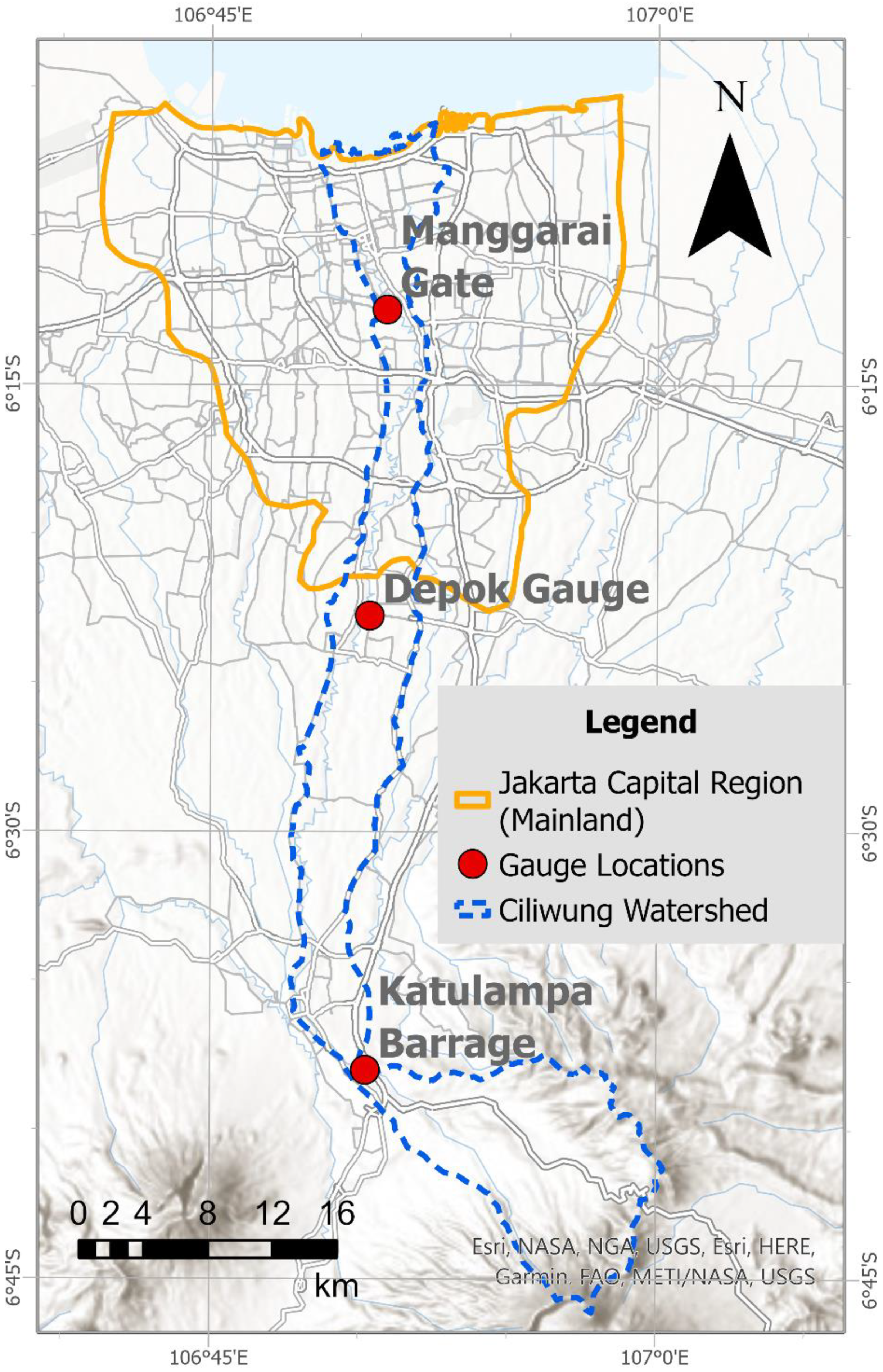
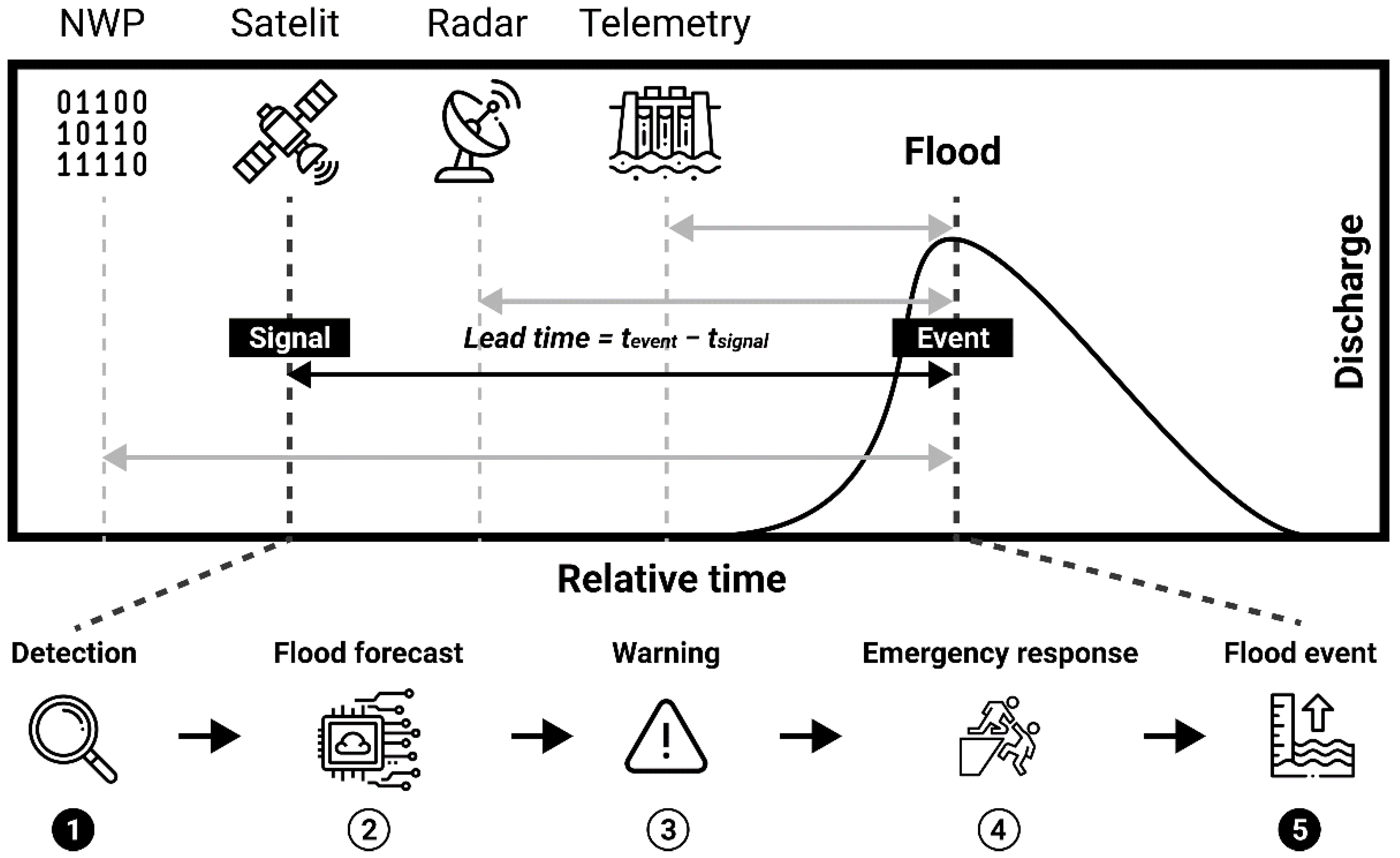
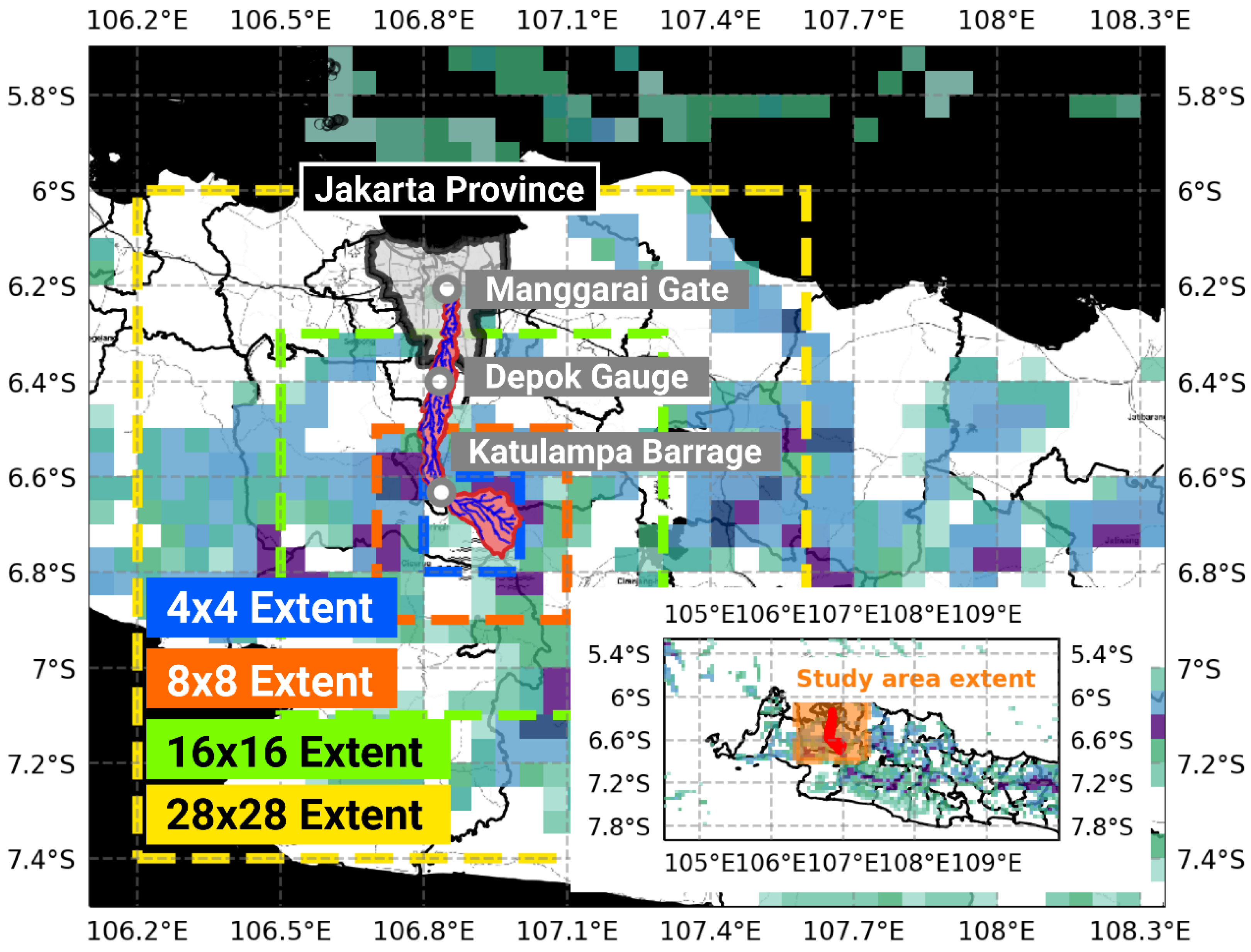
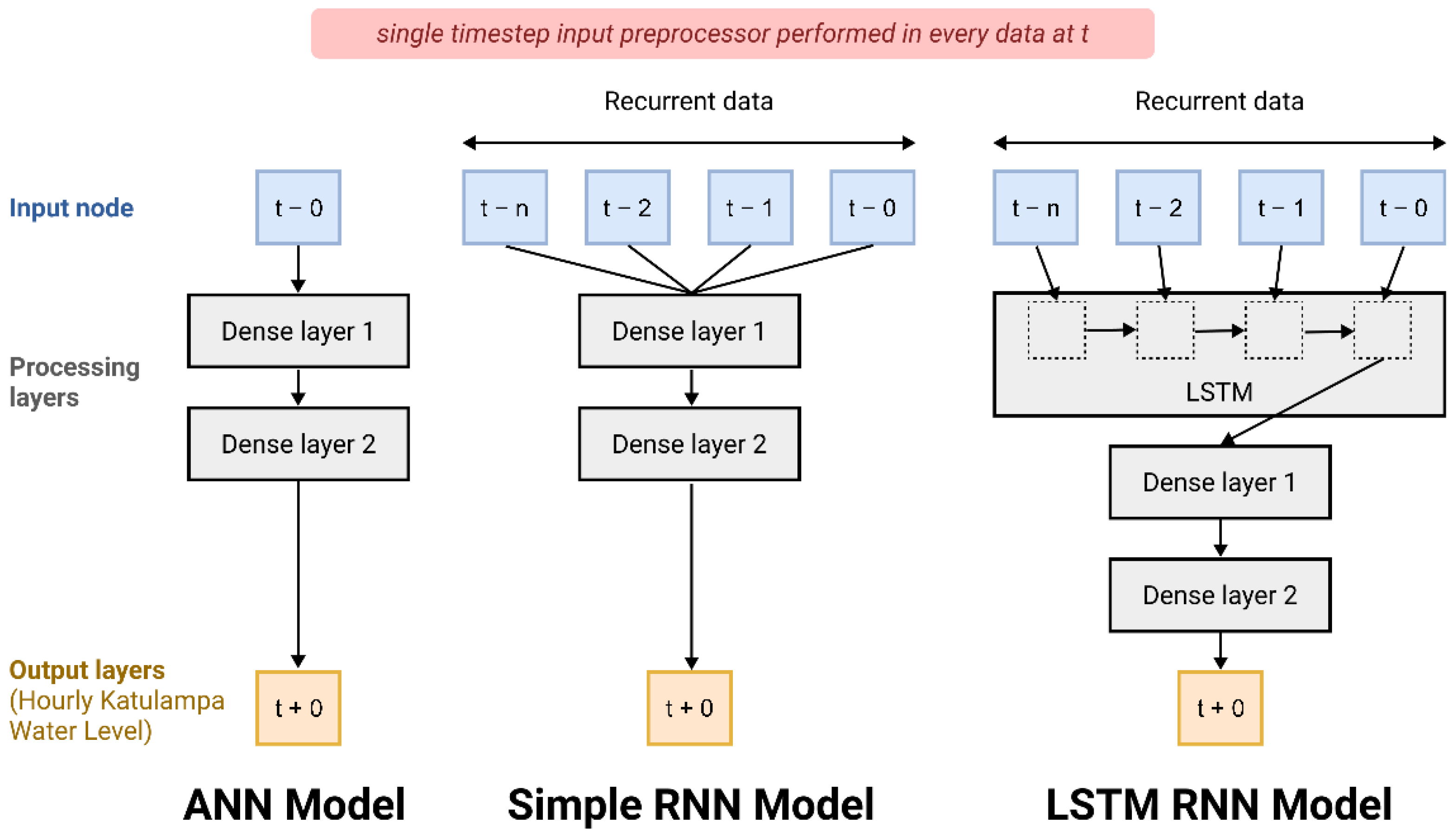
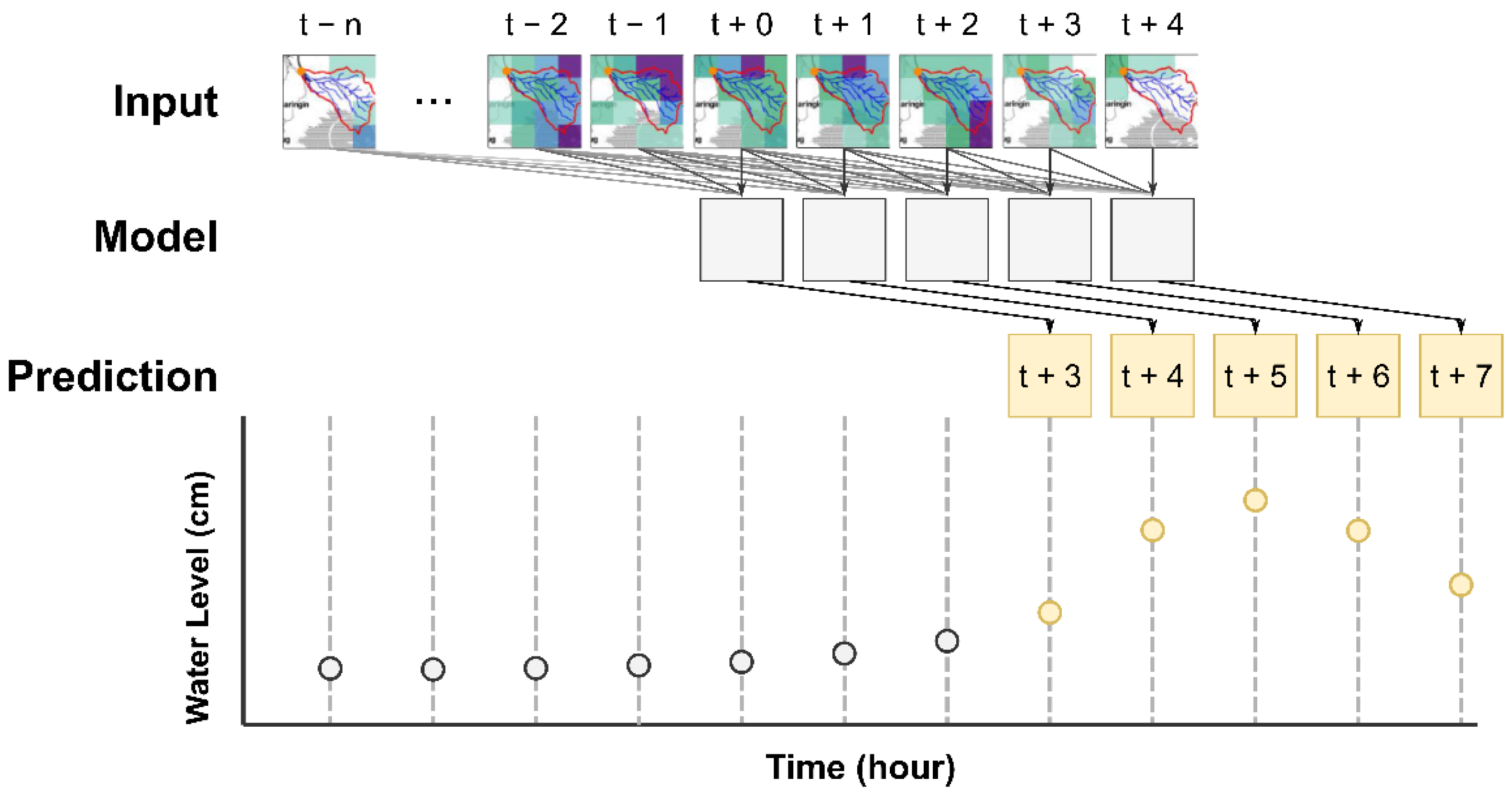
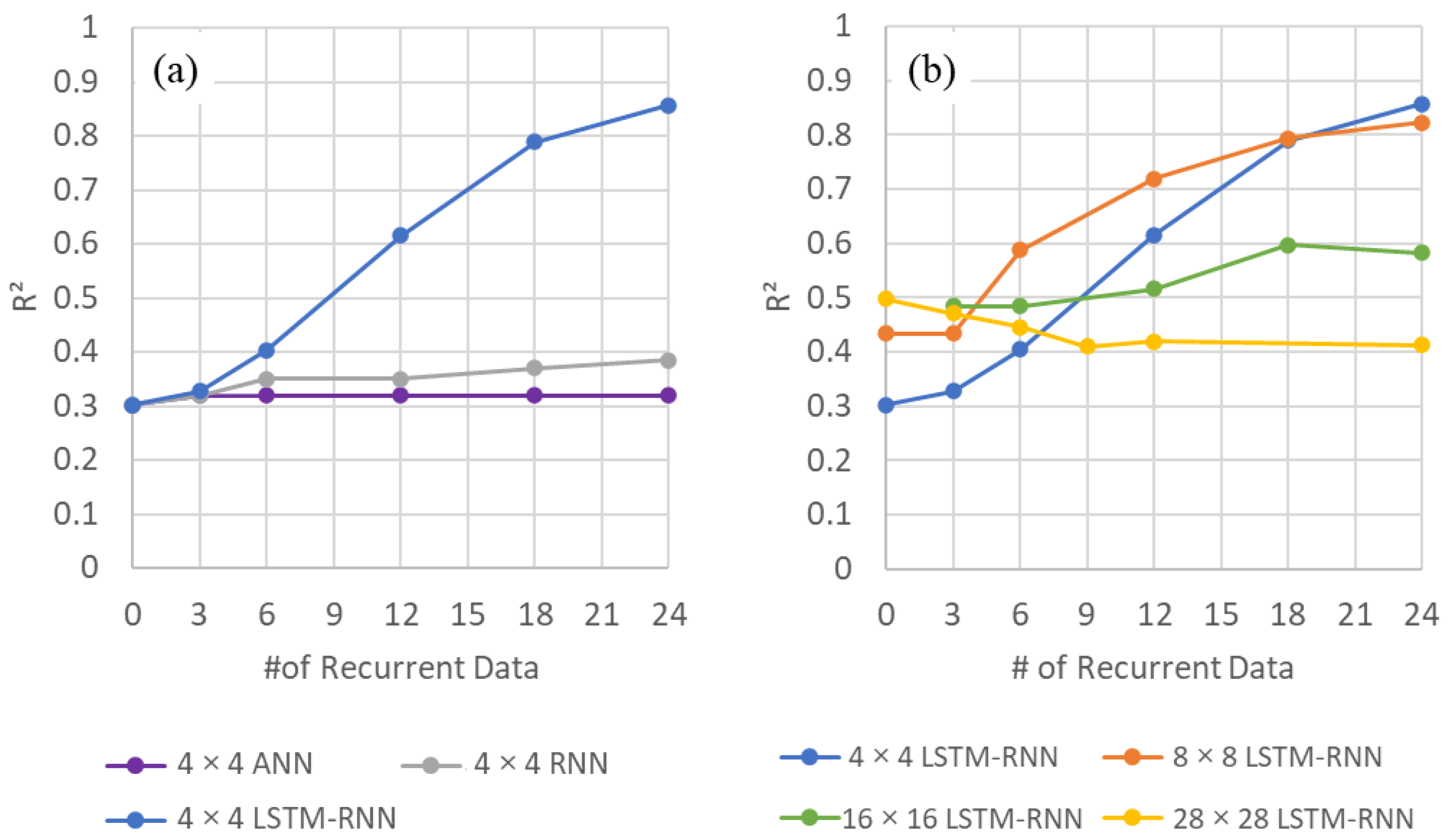
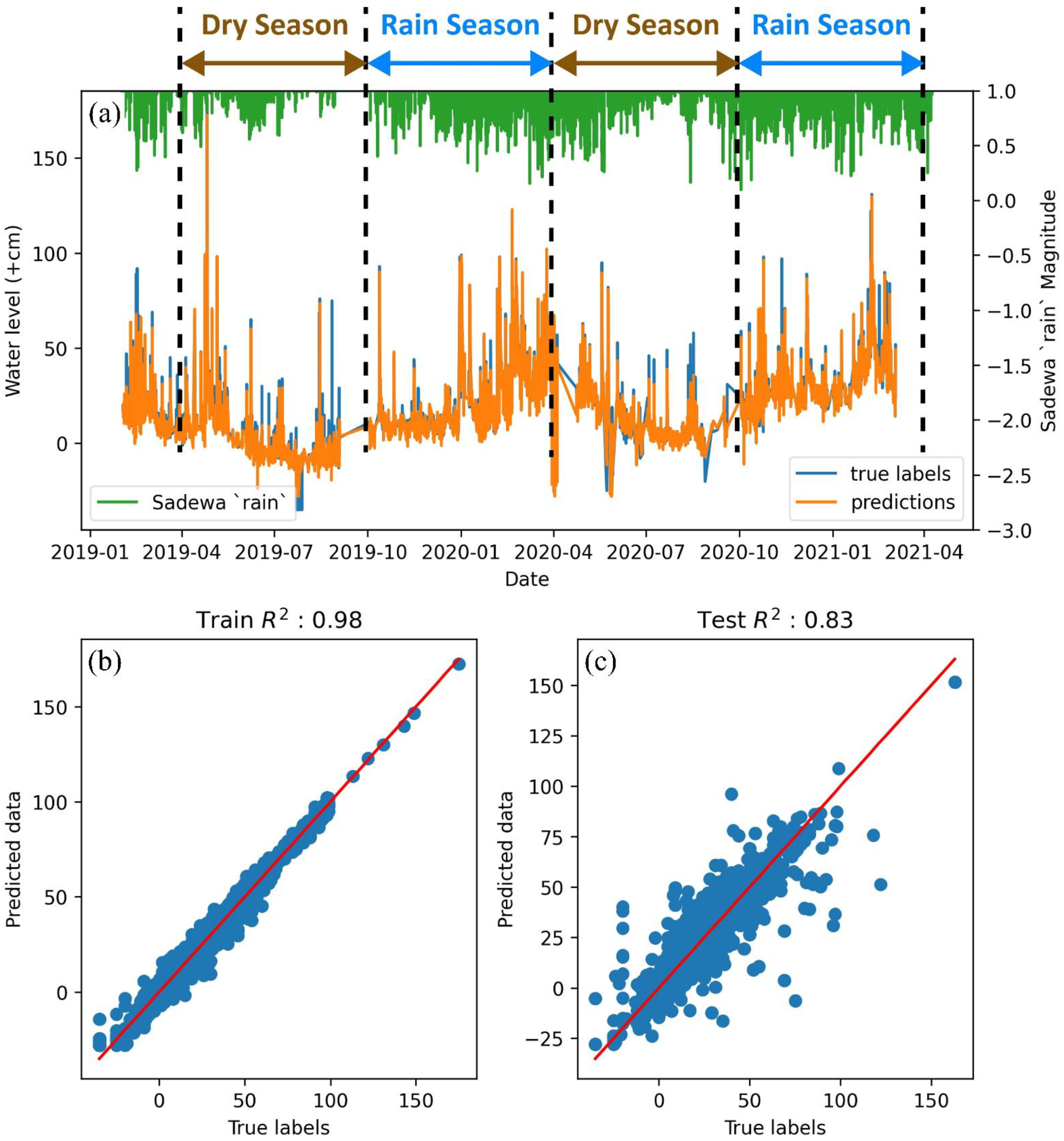
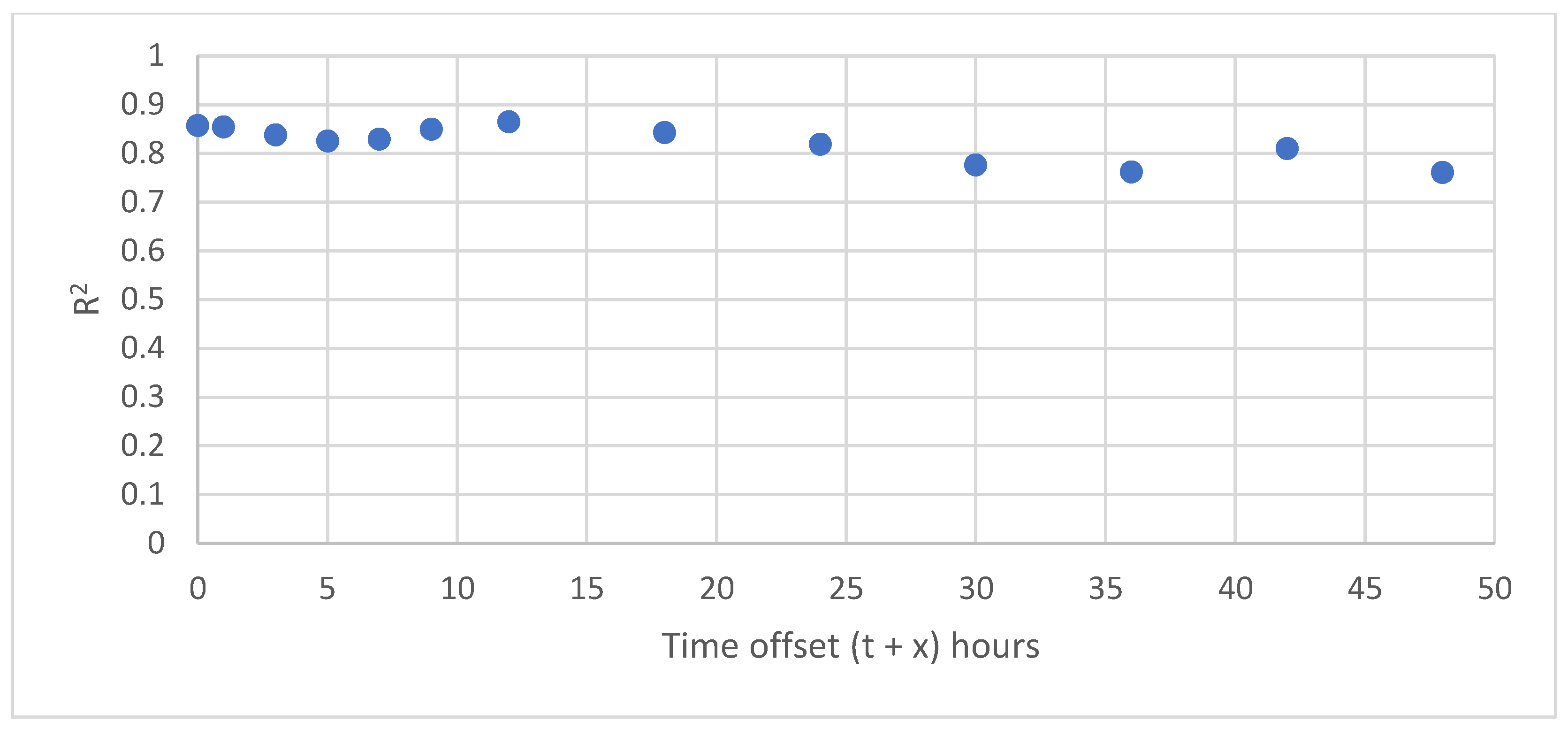
| Output | ||||
|---|---|---|---|---|
| Rainfall | Discharge | Water Level | ||
| Input | Satellite | [31,32] | [43], this research | |
| Radar | [33,34] | |||
| Meteorological | [35,36] | [37] | ||
| Rainfall | [25,44,45] | [38,39,40] | [41,42] | |
| Discharge | [22,23,24,25,26,27,28,29] | |||
| Water Level | [46,47] | |||
| Variable | Dataset | Temporal Resolution | Publicly Available at the Time of Writing | Responsible Agency | |
|---|---|---|---|---|---|
| 1 | Composite observation showing growing cloud criteria (CCLD) | Sadewa-LAPAN | hourly | 1 January 2019–31 December 2020 | The Center for Atmospheric Science and Technology (PSTA)—National Institute of Aeronautics and Space (LAPAN), Indonesia |
| 2 | Near-infrared observation channel (B04) | ||||
| 3 | Peak cloud temperature observation channel (IR1) | ||||
| 4 | Water vapor observation channel (IR3) | ||||
| 5 | Visible observation channel (VIS) | ||||
| 6 | Predicted cloud fraction (cloud) | ||||
| 7 | Predicted perturbation pressure (psf) | ||||
| 8 | Predicted total column water vapor (qvapor) | ||||
| 9 | Predicted accumulated rain per hour (rain) | ||||
| 10 | Predicted surface temperature (sst) | ||||
| 11 | Predicted wind speed and direction at an altitude of 1.458 m (wind) | ||||
| 12 | Predicted wind speed and direction at an altitude of 11.787 m (winu) | ||||
| 13 | Predicted near-surface wind speed and direction at 10 m (wn10) | ||||
| 14 | Katulampa water level data | Jakarta DWR telemetry | 10-min | 1 January 2013–31 December 2021 | Jakarta Department of Water Resources |
Publisher’s Note: MDPI stays neutral with regard to jurisdictional claims in published maps and institutional affiliations. |
© 2022 by the authors. Licensee MDPI, Basel, Switzerland. This article is an open access article distributed under the terms and conditions of the Creative Commons Attribution (CC BY) license (https://creativecommons.org/licenses/by/4.0/).
Share and Cite
Kardhana, H.; Valerian, J.R.; Rohmat, F.I.W.; Kusuma, M.S.B. Improving Jakarta’s Katulampa Barrage Extreme Water Level Prediction Using Satellite-Based Long Short-Term Memory (LSTM) Neural Networks. Water 2022, 14, 1469. https://doi.org/10.3390/w14091469
Kardhana H, Valerian JR, Rohmat FIW, Kusuma MSB. Improving Jakarta’s Katulampa Barrage Extreme Water Level Prediction Using Satellite-Based Long Short-Term Memory (LSTM) Neural Networks. Water. 2022; 14(9):1469. https://doi.org/10.3390/w14091469
Chicago/Turabian StyleKardhana, Hadi, Jonathan Raditya Valerian, Faizal Immaddudin Wira Rohmat, and Muhammad Syahril Badri Kusuma. 2022. "Improving Jakarta’s Katulampa Barrage Extreme Water Level Prediction Using Satellite-Based Long Short-Term Memory (LSTM) Neural Networks" Water 14, no. 9: 1469. https://doi.org/10.3390/w14091469
APA StyleKardhana, H., Valerian, J. R., Rohmat, F. I. W., & Kusuma, M. S. B. (2022). Improving Jakarta’s Katulampa Barrage Extreme Water Level Prediction Using Satellite-Based Long Short-Term Memory (LSTM) Neural Networks. Water, 14(9), 1469. https://doi.org/10.3390/w14091469






